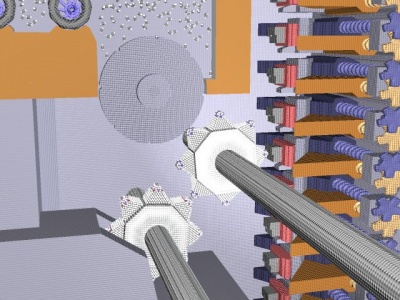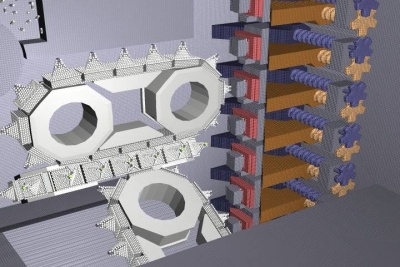Productive Nanosystems From molecules to superproducts


This page is about the the conceptual animation video "Productive nanosystems: From molecules to superproducts".
Watch it here: Productive nanosystems: From molecules to superproducts (InternetArchive link)
To address the common immediate concerns see: Macroscale style machinery at the nanoscale
Contents
Goals
Goals of the concept video
The goals of this animation presumably where a balance of:
- accurate depiction of concepts outlined in the book Nanosystems
- comprehensible depiction of concepts (not over designed over complicated – just giving a hint that there are plenty ways to do it)
- manageable design effort
- show the most critical components worked out in most detail =>
less critical components are worked out in much less detail
they are mostly shown to give a whole system context
Goals of this discussion page
This page is about a brief listing of the sequence of things shown in the video illustrated with screen captures.
Detailed discussions of the stations will be given on dedicated sub-pages.
Up: Discussion of proposed nanofactory designs
List of shown things in the first half
Shown wile zooming in continuously:
- Macroscale resource cartridges
- Cooling channels
- Assembly layers
Shown while zooming out is a list of processing stations.
List of shown stations (as brief listing)
Stations dealing with molecules and molecule fragments:
- Sorting rotors – specifically here: Acetylene sorting pump – Nanosystems pages 374, 378, 379
- Final transfer into machine phase – this may split up into sub processes – Related:Machine phase
- Tooltip loading
- Tooltip preparation
- Carbon deposition – specifically here: di-carbon deposition – Tooltip unloading
Stations dealing with crystolecules and bigger structures:
- Assembly line positioning stage – pallets (adapter pallets)
- NOT SHOWN IN PUBLISHED VERSION – attachment chains for the tool-tips and back-pressure rails
- NOT SHOWN – tooltip positioning stage
- NOT SHOWN – switch of belt type and speed transition
- NOT SHOWN – early stage vacuum lockout
- Routing station (Distribution junction and merging junction)
- Mixed part type stream transport to the next assembly level (here next assembly layer)
- Stream pickup mechanism
- First programmable assembly robot – details largely omitted
- Part streaming assembly – this splits up into three sub processes – gantry robotics involved
- Final lockout at the macroscale
List of shown stations (discussed in more detail)
(wiki-TODO: add discussions of stations and associated screencaps)
Sorting rotors
"Sorting rotors" is the name used in Nanosystems.
Possible critique points of what's shown in the animation:
Possible critique (1): "This has not been worked out in enough detail." – (not applicable when looking at additional work)
Well. Given this is a processing step of core importance there actually has been done more detailed work on this peculiar design problem.
The results juts did not make it into the animation. Either for reasons-of-clarity or it may have been designed only after publication of that video.
Specifically an atomistic model of an acetylene sorting pump with the software Nanoengineer-1 was being designed.
See: Acetylene sorting pump – This was the biggest and most complex modeled diamondoid molecular machine element designed till 2021 (and going).
Possible critique (2): Potential critique points due to the integrated ethyne rods:
- possibly higher radiation damage sensitivity.
- the component parts are possibly quite a bit more difficult to synthesize
Are there maybe alternative solutions that can do without ethyne rods?
See discussion on the page: resource molecule sorting system
Notes
The page on this wiki that is associated is: Gemstone metamaterial on chip factories
The page "Advanced productive nanosystems" is more generally about all kinds of proposed advanced manufacturing systems (more and less feasible) that go into the direction of gem-gum technology.
Related
- Discussion of other proposed nanofactory designs
- Gemstone metamaterial on chip factories
- Design of gem-gum on-chip factories
- Advanced productive nanosystems – Disambiguation page
- More generally: Advanced productive nanosystems